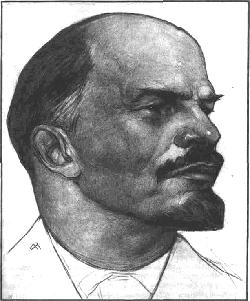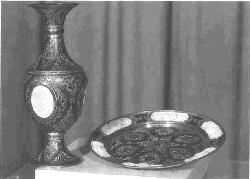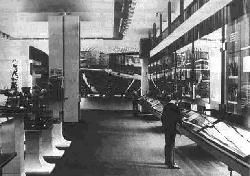Lenin's real-life drawing by N.AndreevPermanent and temporary exhibits devoted to V.I.Lenin are located in the 11 halls on the third floor of the Museum. The exhibition on display in the passages between the halls is called "The Image of V. I. Lenin in Political Placards".
One of the halls exhibits gifts given to Lenin by working people. Among the gifts, some are humble and rather symbolic: a piece of turf from the first Soviet turf cultivations, an electric insulator and other gifts that witness the first steps of Soviet industry. There is a photoalbum in the hall with photographs given to Lenin by factory workers, specially made china plates, vases and cups with dedicatory inscriptions-a gift from the workers of the ancient Russian china factory, Dulyovo. The metallurgists from the Moscow Hammer and Sickle factory made portraits of K. Marx and F. Engels in iron high-relief. ... In a neighbouring hall there is a permanent exhibit of paintings dedicated to Lenin and the first years of the Soviet state. The authors of these paintings are the famous artists I. Brodsky, A. Gerasimov, V. Serov, E. Kibrik and others. There is an interesting exhibit of folk art here. Carpets, silk rugs and mosaics with portraits of V. I. Lenin are presented in this exposition. The works are made of various materials-anything from silk to feathers. Their authors are folk artists from Azerbaijan, Armenia, the Russian Federation, Turkmenia, Uzbekistan, the Ukraine, Byelorussia, Tajikistan and other Soviet republics. The hall next door is completely devoted to the works of the renowned Soviet artist and sculptor N.Andreyev. He was one of the few artists who made real-life drawings of Lenin-at meetings and gatherings, in his short hours of rest and conversation with friends or with ideological opponents. Small, sometimes no bigger than a palm of the hand, his drawings portray Lenin as the person, thinker, and fighter. All the drawings exhibited in the hall are originals. That is why this hall is always dimly illuminated and the drawings themselves are protected by special glass. V. I. Lenin's Party Card number 224332, issued by the Party's Zamoskvorechye District Committee in Moscow in 1920, attracts, as a rule, the attention of visitors. Also on display are the Party Cards No. 0000001 issued in 1927 and No. 00000001 issued in 1973 in the name of the founder of the CPSU V. I. Lenin. Documents and materials in other halls reveal the image of V.I.Lenin in cinema and theatre. The film sequences of Lenin in real life attract special attention, although these are few in number. In one of the halls there are more than 350 documentary photographs of the places where V. I. Lenin lived, worked, visited or stayed en route. The photographs are arranged in chronological order-from his home in Simbirsk where Lenin was born, to the Mausoleum on Red Square where he lies in rest. Here one can see the flourescent talking map which points out the memorial places of Lenin, and watch slides as well. The permanent exhibit on the theme "V.I. Lenin and the Present-Day Revolutionary Movement" is located in the largest hall on the third floor. The materials of this exhibition portray V. I. Lenin as the man of genius who continued the revolutionary teachings of K. Marx and F. Engels, theoretician and leader of the socialist revolution, and reveal the basic revolutionary forces of the present—the worldwide system of socialism, the struggle of the working class In capitalist countries, and the national liberation movement of our time.
Lenin Museum Index |
| Index Lenin Museum | 1870-1905 years |
Revolution October 1917 |
Soviet Union Formation | Last years | Russian |


